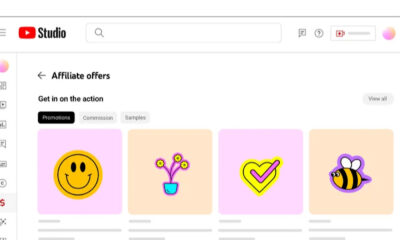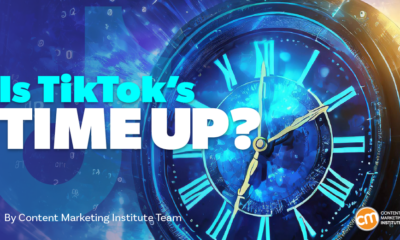SOCIAL
Are TikTok and Other Emerging Channels Too Ephemeral to Track?

With over 1 billion users — and 105 million in North America alone — TikTok is a centerpiece of cross-generational conversations, pop culture references, and daily use.
From a top-level view, it’s no wonder our dopamine-driven brains have registered accounts in droves. But if our primal drivers were the only explanation, TikTok wouldn’t have risen to the ranks. From 2018 to 2020, TikTok’s user base has grown by 800%. Its “it factor” shown in a 2021 Nielson study – a unique ability to inspire belonging, community, and authenticity – is surpassing existing tech conglomerates who frankly are looking to replicate its design.
Yet these unique, core characteristics that inspire rare possibilities to share information – i.e. quick videos, shareable music, catchy hooks, and clever audio overlays – have underpinned a new problem for brands, public figures, celebrities, and influencers gaining traction: How, and by which metrics and comparatives, do you track success when the content itself is quite ephemeral?
The rise of social listening technology
Tracking social success outside of in-platform metrics isn’t a new problem, so many tech companies outside of the platforms have already tried to solve it. In part, they have.
“Developments in social listening technology have helped users understand how their profile or brand can be first in the digital landscape – the algorithms read captions, analyze user behavior, track performance metrics, and even summarize user sentiment based all tied up in a nice bow that you can actually benefit from.
Then audio content came along.
“Audio presents a fundamentally different set of challenges for moderation than text-based communication. It’s more ephemeral and it is harder to research and action,” said Discord’s chief legal officer, Clint Smith, referring to the channel’s moderation struggle around their newest Stage Channels audio feature.
The whole tech stack of audio-based social channels – TikTok, Instagram’s Reels, Clubhouse, Discord’s Stage Channels – have just started to research tracking solutions internally, but the tools for audio content moderation are lagging far behind social listening tools for text-based conversations. A few external companies are developing speech analysis API, but at the moment, there is no streamlined approach to audio conversations online.
The problems with audio moderation
Because of this, social platforms, their users, and their tech integrations don’t have much of a tracking system at all, particularly when it comes to managing problematic commentary or harassment. In these instances, platforms will often resort to blocking users over anything, which creates its own set of accessibility issues.
For example according to Reuters, “Twitter keeps Spaces audio for 30 days or longer if there is an incident, Clubhouse says it deletes its recording if a live session ends without an immediate user report, and Discord does not record at all.”
Managing and tracking any text or image-based commentary, let alone problematic commentary online, isn’t an easy job for humans to start with. There’s a job title for this: Community Manager. But addressing problematic mentions, crisis moments, or something like adverse health events in ephemeral audio conversations? The job market is wide open.
Further, even if platforms create more monitoring parameters internally tomorrow, users and brands would still be left to their own devices to monitor their own content.
So for people, influencers, and brands wanting to moderate content and social listen on audio platforms, the problem is three-fold:
- Audio content is, by nature, more ephemeral than written content. You may be able to transcribe something, but you’ll still lack extra cues, like the visual signals of video or accompanying text comments.
- Few tech companies offer APIs to social listen to audio on new social apps such as TikTok or Discord. For the ones that do, they are still in the beta phase.
- Even if brands wanted to track audio manually, most companies lack the human power, resources, and time to do so.
Not all bad
These overall symptoms of audio content are likely to increase in impact as platforms like TikTok grow and evolve.
But it would behoove users to remember audio content’s benefits as we grapple with ephemerality and nuance – audio itself reigns superior in its ability to connect to an audience. Podcasts started just two decades ago, and now billions of people around the globe engage daily. In the U.S. alone, Insider Intelligence projects listenership to surmount to 144 billion by 2025.
Whether you’re more convinced by TikTok and other audio-based channels’ inevitable challenges or its research-backed potential, there’s a reason so many are engaging, and from this view, the bandwagon doesn’t look so bad.
SOCIAL
Snapchat Explores New Messaging Retention Feature: A Game-Changer or Risky Move?

In a recent announcement, Snapchat revealed a groundbreaking update that challenges its traditional design ethos. The platform is experimenting with an option that allows users to defy the 24-hour auto-delete rule, a feature synonymous with Snapchat’s ephemeral messaging model.
The proposed change aims to introduce a “Never delete” option in messaging retention settings, aligning Snapchat more closely with conventional messaging apps. While this move may blur Snapchat’s distinctive selling point, Snap appears convinced of its necessity.
According to Snap, the decision stems from user feedback and a commitment to innovation based on user needs. The company aims to provide greater flexibility and control over conversations, catering to the preferences of its community.
Currently undergoing trials in select markets, the new feature empowers users to adjust retention settings on a conversation-by-conversation basis. Flexibility remains paramount, with participants able to modify settings within chats and receive in-chat notifications to ensure transparency.
Snapchat underscores that the default auto-delete feature will persist, reinforcing its design philosophy centered on ephemerality. However, with the app gaining traction as a primary messaging platform, the option offers users a means to preserve longer chat histories.
The update marks a pivotal moment for Snapchat, renowned for its disappearing message premise, especially popular among younger demographics. Retaining this focus has been pivotal to Snapchat’s identity, but the shift suggests a broader strategy aimed at diversifying its user base.
This strategy may appeal particularly to older demographics, potentially extending Snapchat’s relevance as users age. By emulating features of conventional messaging platforms, Snapchat seeks to enhance its appeal and broaden its reach.
Yet, the introduction of message retention poses questions about Snapchat’s uniqueness. While addressing user demands, the risk of diluting Snapchat’s distinctiveness looms large.
As Snapchat ventures into uncharted territory, the outcome of this experiment remains uncertain. Will message retention propel Snapchat to new heights, or will it compromise the platform’s uniqueness?
Only time will tell.
SOCIAL
Catering to specific audience boosts your business, says accountant turned coach

While it is tempting to try to appeal to a broad audience, the founder of alcohol-free coaching service Just the Tonic, Sandra Parker, believes the best thing you can do for your business is focus on your niche. Here’s how she did just that.
When running a business, reaching out to as many clients as possible can be tempting. But it also risks making your marketing “too generic,” warns Sandra Parker, the founder of Just The Tonic Coaching.
“From the very start of my business, I knew exactly who I could help and who I couldn’t,” Parker told My Biggest Lessons.
Parker struggled with alcohol dependence as a young professional. Today, her business targets high-achieving individuals who face challenges similar to those she had early in her career.
“I understand their frustrations, I understand their fears, and I understand their coping mechanisms and the stories they’re telling themselves,” Parker said. “Because of that, I’m able to market very effectively, to speak in a language that they understand, and am able to reach them.”Â
“I believe that it’s really important that you know exactly who your customer or your client is, and you target them, and you resist the temptation to make your marketing too generic to try and reach everyone,” she explained.
“If you speak specifically to your target clients, you will reach them, and I believe that’s the way that you’re going to be more successful.
Watch the video for more of Sandra Parker’s biggest lessons.
SOCIAL
Instagram Tests Live-Stream Games to Enhance Engagement

Instagram’s testing out some new options to help spice up your live-streams in the app, with some live broadcasters now able to select a game that they can play with viewers in-stream.
As you can see in these example screens, posted by Ahmed Ghanem, some creators now have the option to play either “This or That”, a question and answer prompt that you can share with your viewers, or “Trivia”, to generate more engagement within your IG live-streams.
That could be a simple way to spark more conversation and interaction, which could then lead into further engagement opportunities from your live audience.
Meta’s been exploring more ways to make live-streaming a bigger consideration for IG creators, with a view to live-streams potentially catching on with more users.
That includes the gradual expansion of its “Stars” live-stream donation program, giving more creators in more regions a means to accept donations from live-stream viewers, while back in December, Instagram also added some new options to make it easier to go live using third-party tools via desktop PCs.
Live streaming has been a major shift in China, where shopping live-streams, in particular, have led to massive opportunities for streaming platforms. They haven’t caught on in the same way in Western regions, but as TikTok and YouTube look to push live-stream adoption, there is still a chance that they will become a much bigger element in future.
Which is why IG is also trying to stay in touch, and add more ways for its creators to engage via streams. Live-stream games is another element within this, which could make this a better community-building, and potentially sales-driving option.
We’ve asked Instagram for more information on this test, and we’ll update this post if/when we hear back.
-

 WORDPRESS7 days ago
WORDPRESS7 days agoTurkish startup ikas attracts $20M for its e-commerce platform designed for small businesses
-

 MARKETING6 days ago
MARKETING6 days agoRoundel Media Studio: What to Expect From Target’s New Self-Service Platform
-

 SEO5 days ago
SEO5 days agoGoogle Limits News Links In California Over Proposed ‘Link Tax’ Law
-
SEARCHENGINES6 days ago
Daily Search Forum Recap: April 12, 2024
-

 SEARCHENGINES7 days ago
SEARCHENGINES7 days agoGoogle Search Results Can Be Harmful & Dangerous In Some Cases
-

 MARKETING7 days ago
MARKETING7 days agoUnlocking the Power of AI Transcription for Enhanced Content Marketing Strategies
-

 SEO5 days ago
SEO5 days ago10 Paid Search & PPC Planning Best Practices
-

 SEARCHENGINES5 days ago
SEARCHENGINES5 days agoGoogle Core Update Volatility, Helpful Content Update Gone, Dangerous Google Search Results & Google Ads Confusion















You must be logged in to post a comment Login